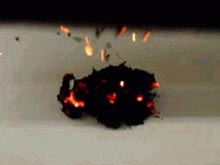
Animals may have beaten upright plants to land.
The oldest fossils of footprints ever found on land hint that animals may have beaten plants out of the primordial seas. Lobster-sized, centipede-like animals made the prints wading out of the ocean and scuttling over sand dunes about 530 million years ago. Previous fossils indicated that animals didn’t take this step until 40 million years later.
“It’s staggering that we thought for all this time that animals appeared on land

It sounds like a photographer’s worst nightmare: the light of the flashbulb causes the subject of the photo to burst into flames. But that’s exactly what happened recently when researchers snapped a picture of some single-walled carbon nanotubes, tiny cylinders of pure carbon. The findings, described in a report published in the current issue of the journal Science, suggest that the minute straws could be used as triggering devices or for remote light-induced ignition.
The discovery was ma

The scientists from I.P. Pavlov Institute of Physiology, Russian Academy of Sciences, have investigated the intellectual abilities of chimpanzees in comparison with the children from a nursery school in Koltushy near St. Petersburg. They asked both to build the pyramids of cubes of different size. The children with the retention of speech development aged from 2 to 7 and two chimpanzees, female (aged 7) and male (aged 11) ones, took part in the experiment. The children and the apes were shown a pyra

Researchers at the University of Warwick’s Warwick Process Technology Group have devised a process that turns wet waste from sewage farms and paper mills into a source of power.
University of Warwick researcher Dr Ashok Bhattacharya and his team are part of a Europe wide consortium that have cracked the problem of how to extract very pure levels of hydrogen from wet bio-matter, such as sewage or paper mill waste. This very pure hydrogen can then be used in “fuel cells” to power homes, factor

Is it possible to make components out of organic polymers (plastics) whose structure is such that severed nerves can grow right into them and connect with electrodes in a prosthetic hand, for example? This is one of the research fields for Tobias Nyberg at the Section for Biomolecular and Organic Electronics at Linköping University, Sweden.
Part of Tobias Nyberg’s dissertation is based on collaboration with cell biologist Helena Jerregård. Her task is to find ways to get tangled nerves to s

A team including researchers at the Total Defense Research Institute, NBC Defense, in Umeå, Sweden, and the Department of Molecular Biology, Umeå University, are publishing in this week’s issue of Science new findings that show that the protein Ymt is of crucial importance for the capacity of the plague bacterium to survive and spread the plague via flea vectors. Professor Åke Forsberg and visiting researcher Dr. Peter Cherepanov are studying the properties that enable the plague bacterium Yersinia

Researchers from Delft University of Technology in The Netherlands have been able to initiate a controlled movement in the very heart of an atom. They caused the atomic nucleus to…

The integration of efficient, scalable, and cost-effective nanoscale lasers is essential for optical interconnects, medical diagnostics, and super-resolution imaging. Particularly, telecom-band NW lasers are promising for on-chip coherent light sources…

Smile for the camera! An interaction between an elliptical galaxy and a spiral galaxy, collectively known as Arp 107, seems to have given the spiral a happier outlook thanks to…

Research led by the Institute for Bioengineering of Catalonia (IBEC) has studied the migratory movement of groups of cells using light control. In processes such as embryonic development, wound healing…

Brigham researchers develop strategy to improve immunotherapy by helping T cells penetrate and kill tumor cells. Fighting cancer is exhausting for T cells. Hostile tumor microenvironments can drain their mitochondrial…

New method developed by researchers of KIT and voxalytic GmbH allows easy elucidation of the spatial arrangement of atoms –tool for drug discovery. The chirality of a molecule refers to…

The global use of lithium-ion batteries has doubled in just the past four years, generating alarming amounts of battery waste containing many hazardous substances. The need for effective recycling methods…

A new study led by researchers at the University of Minnesota Twin Cities is providing new insights into how next-generation electronics, including memory components in computers, breakdown or degrade over…

How synthesis methods have a profound impact on disordered materials. A new study reveals how different synthesis methods can profoundly impact the structure and function of high entropy oxides, a…

The AQT quantum computer, featuring 20 qubits based on trapped-ion technology, is now operational at LRZ’s Quantum Integration Centre (QIC), making it the first of its kind in a computing…

The CHAI joint project aims to optimize corrosion management in ports and waterways. The federal state of Schleswig-Holstein is funding the CHAI research project with a total of 900,000 euros….

A research team from the Scuola Superiore Sant’Anna in Pisa has developed the prosthesis of the future, the first in the world with magnetic control. It is a completely new…